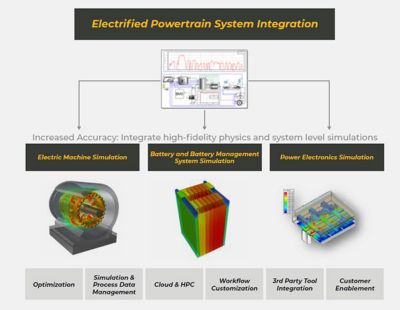-
United States -
United Kingdom -
India -
France -
Deutschland -
Italia -
日本 -
대한민국 -
中国 -
台灣
-
-
產品系列
查看所有產品Ansys致力於為當今的學生打下成功的基礎,通過向學生提供免費的模擬工程軟體。
-
Ansys Blog
September 4, 2020
The Race to Electric Mobility: Are You One of the 75%?
In a recent survey,1 75% of consumers state they expected to own an electric vehicle in their lifetime and that environmental impact plays an important role in shaping their decisions; 63% think about emissions when traveling and 60% would even consider riding an electric plane for environmental reasons.
Mobility plays a critical role in driving the global economy and enables people to connect for business and pleasure. With a global population expected to swell to 10 billion by 2050, how can governments, regulators, companies and individuals balance the competing forces of environmental responsibility with the inevitable demand for increased movement?
Electric vehicles, whether traversing land, sea or air, have the potential to solve this challenge. Today, over the entire vehicle lifecycle, a European report2 suggests that electric vehicles emit up to 30% fewer greenhouse gas emissions than gasoline equivalents, and this could rise to over 70% by 2050.
Meet E-Mobility Challenges
However, the mass adoption of electric vehicles means some significant market needs must be addressed:
- Cost: An electric car can cost around $10,000 more than its gasoline equivalent, with the battery being a major source of that cost increase3.
- Range and Payload: For electric cars, consumer range anxiety, access to charging and speed of charging are real concerns. For even small electric aircraft to carry an economically viable payload could require batteries with an energy density at least twice that of the most advanced batteries commercially available today4.
- Performance: When every watt counts, minimizing losses across the electrified powertrain is critical. The U.S. Department of Energy reported that an electric drive system accounts for about 20% of energy loss5. While this is a substantial improvement over a gasoline equivalent, it still leaves room for improvement.
- Safety and Security: With the proliferation of electronic components and associated software must come the demonstration that these systems are both functionally safe and cybersecure.
Engineers are at the forefront of delivering the technical advances that address these market needs, focused on four critical development areas: battery and battery management systems, electric machines, power electronics, and electrified powertrain system integration.
Simulation Advances Electrification Efforts
Simulation is playing a key role in each of these areas, enabling industry pioneers like VW, A123 Systems and Zunum Aero to realize significant benefits. Ansys case studies have shown simulation can help reduce overall electric vehicle development time by up to 50%,6 reduce electric drive development time by 75%7 and improve power density and energy efficiency by 12%8.
Ansys provides a comprehensive multiphysics electrification simulation solution that leverages high-fidelity physics from the component to the system, including automatic generation of safety-certified embedded software and functional safety analysis in an open environment. This solution is used for optimization, simulation data, process management, workflow customization, and for access to cloud and high-performance computing resources. It also supports third-party integration for deployment across the enterprise. This electrification simulation solution is backed by technical support, services and training. A visual representation of the solution and its key elements is shown below.
To explain how simulation is supporting the race to electrification, we have published a new e-book that details the engineering challenges that underpin the critical market needs. It articulates how some of the pioneers in electric mobility are addressing electrification challenges and the impact they are making with simulation. The e-book also presents a summary of the overall Ansys electrification solution and its key elements of electric machine simulation; battery and battery management system simulation; power electronics simulation; and the integration of the entire electrified powertrain system.
Download the “Engineering What’s Ahead: Electric Mobility” e-book.
Sources
- Flying Cleaner Skies and Driving Greener Roads. Data collected through a consumer survey. Ansys enlisted Atomik Research and its team of MRS-certified researchers to conduct the online survey in March 2020. The sample included 16,037 adults 18-and-over, from the U.K., U.S., DACH (Austria, Germany and Switzerland), France, Sweden, Japan, China and India.
- EEA Report Confirms: Electric Cars Are Better for Climate and Air Quality
- Making Electric Vehicles Profitable
- Aircraft Electrical Propulsion – The Next Chapter of Aviation?
- Lucid Air and Ansys: The Full Potential of Electrification
- Danfoss A/S Reduces Time to Market for AC Drives by 75%












